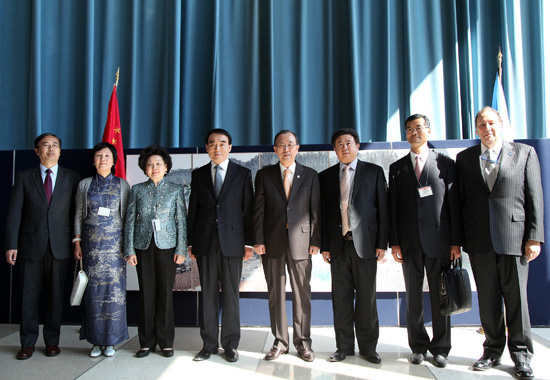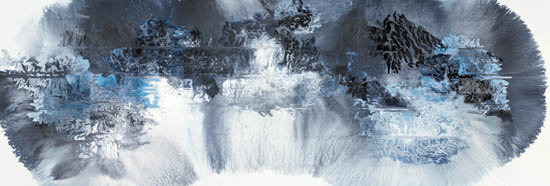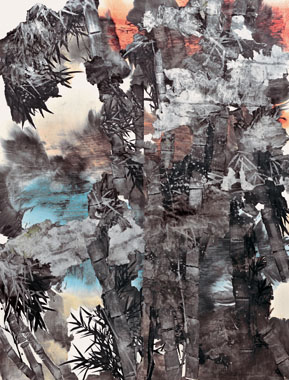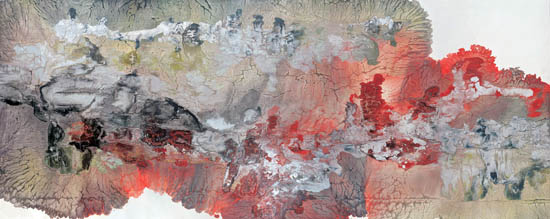In Wang Linxu’s art pursuit, “Super-image” is a kind of harmonious coexistence of the world cultures. Its ideological values reflected in promoting world peace, friendship and multi-element cultural development have been highly recognized and praised by UN and international community. “Super-image” art has been exhibited in a tour from Metropolitan Museum at New York, State University of Maryland, Capitol Library of USA, UN Headquarters to Asian Cultural Center, and two pieces of his works Interactive World and Common Household have been collected by UN Headquarters and aroused extensive attention from all over the world. As far as Wang Linxu is concerned, art exchange, especially fine arts exchange, is attributed to the universal humanist value and limitless communications as its core.
As a Chinese contemporary artist with significant influence on the global stage, Wang linxu, permanent member of CPPCC and vice principal of Central Minzu University, presented its ink and wash Super-image art through exploration and experiments for 30 years. His works, in grand and magnificent image formality, demonstrate the essence and infinity of our material world, which now becomes an artistic sample in communications with the people in this global village. Recently, “Super-image—Wang Linxu Contemporary Ink and Wash Exhibition” was launched in Guangdong Art Museum. This exhibition not only illustrates “Super-image”, a novel art different from traditional one in artistic skills and ideological contents, but also manifests Wang Linxu’s art pursuit with current basis, future orientation and international vision in a comprehensive and centralized way.
This exhibition involves over 30 selected artworks of abundant themes, including Industrial Age, First Snow by Sunset Mountain and Rock Explosion. This initiated “Super-image” art derives from ancient Chinese cultural thinking “Seek Truth Beyond the Image” and integrates western visual arts and Chinese traditional ink and wash technique. Thus a new form of contemporary painting art is born in the world. The exhibited works showcase its contemporary interpretation of varied themes and fully highlight the integration of contemporary art and traditional subject.
Shaking off the limitation of traditional landscape painting, Wang Linxu’s “Super-image” has evolved into a structure in cognition with connected relationship and obtained logical understanding and universal acceptance between man and nature, between oriental and occidental civilizations and between living environment and deconstruction of human nature, all of which have been proved by most audience’s feedback. Mr. Tegegnework Gettu, under-secretary-general of UN gave a positive comment on Wang Linxu’s original achievement on “Super-image” art and expressed his warm welcome for Chinese culture and arts to the world stage.
Long before this domestic sensation about the concept of “Super-image”, Wang Linxu had held two exhibitions in Beijing in October and December 2010 as the debut of “Super-image” to the public. Afterwards, it was exhibited consecutively in the Metropolitan Museum and Modern Art Museum in New York, a contemporary art center of the world. Mr. Ban Ki-moon, secretary general of UN, praised the “Super-image” art as “a new creative achievement in contemporary arts in the world that will arouse people’s love for nature and attention to social development”. During this period, “Super-image” quickly caught responses and feedback from international community and was invited into exhibitions at the Capitol Library, Towson University and State University of Maryland. For this painter who endeavor to promote local culture in the world and search for possible dialogue with foreign counterpart, the recognition by international community and initial but outstanding success of “Super-image” art in overseas promotion bear a profound significance for reference.
Wang Linxu’s art achievement is well-received by many experts in fine arts both at home and abroad. As Liu Dawei commented, “instead of concrete image, specific property or locality, Wang Linxu’s ‘Super-image’ deals with the inner spiritual sources, which therefore can be eaily accepted by people of different cultural backgrounds and varied races”.
As Pi Daojian, an art critic, said, “What can Chinese culture do for this world? What can we contribute to this world of globalization where science and technology are worshiped like God, priority is given to materialism, ecological environment is deteriorating, constant cultural shock and power politics overwhelms? I suppose Wang Linxu’s ‘Super-image” art has provided us with revelations”. On this basis, this exhibition should be regarded as a returning point with new implication. Regardless of the change in artistry, the significance lies in that Wang Linxu’s success will enlighten us to give an in-depth thought on how to promote Chinese culture and arts in the world stage to win genuine applause. Under such a condition, the Chinese fine art circles and art critics will reevaluate the “ecological aesthetics” advocated in “Super-image” and ponder over the development direction and path of Chinese fine arts with a careful study of pros and cons of “Super-image” art.
Besides innovation in painting skills, materials and visual effect, “Super-image” art intends to demonstrate grand living condition and prospect as well as ecological difficulty confronting the entire human being with inter-cultural art language and broad vision. Then onto the level of essence of life and art, it calls for human beings to transcend shortsighted interest and dispute and pursue common hope. So far, it is still quite rare pursuit for global artists and that explains its extensive popularity in the international community. Quite a few famous artists in China regard it as a unique art sample for innovation. “‘Super-image’ art involves future concern, focus and criticism over the industrial society and a saint responsibility for human harmony with nature” Dao Zi, professor at Tsinghua University, commented.
Mere discussion on painting’s content in the approach of expression, technique and language will fail to cover the whole contents of “Super-image” art. As Wang Hongjian, professor at Central Academy of Fine Arts, said, an artist’s ink, brush and reflection must be connected to his or her thoughts. From an international macro perspective, “Super-image” focuses on significant issues for mankind such as war and peace as well as life and disaster. In combination with traditional Chinese idea that Man integration as part of nature, Wang Linxu expresses a humanist emotion and his unprecedented art language has reached a height of contemporary ink and wash art creation. “We have been talking about going abroad, integration of East and West or tradition and modernity. Wang Linxu’s renew knowledge and art practice about the painting material and ink and wash just provide an inspiration—combination of art creation with current life” Luo Yiping, director general of Guangdong Art Museum, concluded.


















